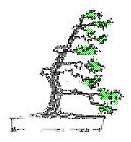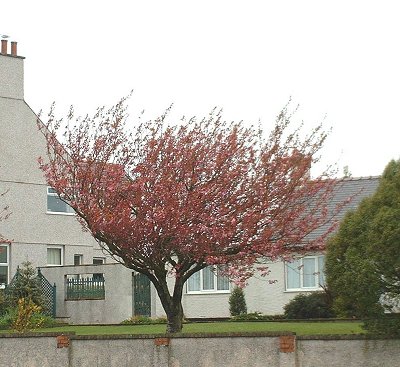The basic Japanese tree forms have evolved over the years as a way of categorising bonsai and also helping to establish basic guidelines for styling trees.
These form definitions are helpful to the beginner to help develop an eye for different tree shapes and to help define different trunk and branch patterns.
It is very useful for the beginner to start his or her bonsai styling education by learning these basic forms. However, once learnt, the enthusiast must not make the mistake of being bound by these definitions either.
Forms Vs Styles In many textbooks, the following forms are described as bonsai styles, however there is a strong movement, instigated by Walter Pall, to make a distinction between the form ( according to the predominant feature or direction of the trunk) and the style (the manner in which the form is displayed), and for this reason this article follows this re-categorisation by listing bonsai forms.
In summary: The form describes the basic shape of the tree as defined by trunk, the style describes the the way in which the tree has been styled (for instance windswept, near or far away from the viewer, naturalistic or abstract).
BONSAI FORMS DESCRIBED This is a list of the basic bonsai forms but is by no means a complete list of all bonsai forms or the many variations of the different forms that exist.
Informal Upright Form This form is the most commonly seen in Bonsai and in nature. It can be used for most tree species. The trunk can twist, turn and change direction with a number of bends along its length though the growth is basically upwards.
Branches tend to emerge from the outside of bends. Branches emerging directly from the inside of bends often look awkward.The overall silhouette of an informal upright is often irregularly triangular but does not have to be.
Coniferous species such as Pines and Junipers are often seen with largely horizontal branching and clearly defined 'clouds' of foliage.

Informal Upright Korean Hornbeam by Harry Harrington with natural deciduous branching.
Deciduous and broadleaf species such as Elms, Maples and box should have predominantly naturally ascending branching and should not have clearly defined foliage pads; a too-common mistake is for deciduous species to be styled with horizontal branching, clearly defined foliage pads and 'pompoms' of foliage.

Image of a poorly-styled deciduous informal upright form with horizontal branching, too clearly defined 'pompoms' of foliage. Bonsai styled in this way are too-commonly seen in bonsai books and are the result of poor and over-simplified attempts at bonsai styling.

Informal upright wild English Oak. Note this does not have a triangular silhouette.
Formal Upright Form In this form the trunk is completely straight and upright. Previously a popular form but now rarely seen as the majority of upright trees have some movement that make them informal uprights.
Ideally the trunk should display an even taper from base to apex. This form replicates trees growing unimpeded in open growing conditions without competition from other trees. The branches leave the trunk alternatively from left to right to back and no branches face the front until the top third of the tree. All the branches will be mainly horizontal or slightly drooping as if weighed down by snow in winter. This can be a difficult form to carry out convincingly and it is recommended that only trees with a naturally straight trunk be used. The silhouette of a formal upright is triangular though not strictly symmetrical.
Deciduous species are unsuitable as formal uprights. Coniferous species such as yew, swamp cypress and cryptomeria make good candidates.
Broom Form The broom form replicates the way many deciduous trees grow in nature given ideal growing conditions with no competition from other trees. It is particularly recommended for fine branching species particularly Ulmus and Zelkova but all deciduous and broadleaf tree species are suitable. The broom form is not suitable for coniferous species including pines and junipers.
The broom form can be further divided into two types, the formal and the informal broom.
Formal Broom Form The best known broom form has a main trunk that divides at a certain point into three or more branches of roughly equal thickness which grow out diagonally upwards from the central trunk.
The silhouette of the tree resembles an upturned Japanese broom ; hence the name.

Classic Formal Broom Chinese Elm by Harry Harrington
The main trunk of the formal broom tends to be 1/3 of the overall height of the bonsai. There are no horizontal branches; all branching is placed diagonally in a fan-shape with no, or very few, crossing branches.
There are variations of the classic formal broom; there can be a main trunk that runs from base to apex of the tree. However, unlike a (in)formal upright, the branches are nearly as thick and dominant as the central trunk, but all of these branches are placed at upturned diagonals from the main trunk, forming a broom silhouette.

(left) Classic formal broom and (right) a variation of the classic formal broom
Informal Broom Form There is no reason why a trunk without a straight trunk cannot be used for the broom form; a trunk with bends or movement is simply an informal broom. Quite possibly the most common form of broom seen in nature.
 Slanting Form
Slanting Form In this form the trunk itself slants as though growing toward the light or as though exposed to strong wind. The trunk can be straight or curved with branches on the sheltered side lower than their counterparts on the other side of the trunk. An important feature with this form is that the nebari or roots should appear to anchor the tree to stop it 'falling'. The roots on the side to which the tree leans should be short and compressed whilst the roots on the opposite side should be strong and dominant, anchoring the tree into the ground.

Field-growing English Oak with a slanting form

Slanting form Hawthorn by Harry Harrington
Windswept Form The windswept form is one of the most difficult forms to portray as a bonsai though is often one attempted by beginners for its dramatic features.

Example of a cliched 'windswept' bonsai.
The windswept form is also one of the most misunderstood forms. The typical windswept bonsai is styled with all of its branches on one side of the trunk flung out towards one side by some invisible force! This cliche rather spoils the form but is often repeated.
The windswept form can be divided into two different types; the tree that grows under near continual winds (like those that grow on windswept coasts) and secondly, trees that are hit by a sudden gust of wind.
Permanently Windswept Bonsai In nature, trees that are subject to strong winds on a regular basis will look windswept, even on a still day (see images below). It is obvious to the eye that the tree is shaped by the wind.
Growth is predominantly in one particular direction;the branches will tend to be longer on the sheltered side of the tree. Branches on the side of the tree that face the wind will be shorter.
The mistake that many enthusiasts make is to believe that a windswept tree cannot have branches or trunks facing into the wind. On occasions, trees can be found with branches on just one side particularly in very exposed coastal positions. My opinion is that these are often ugly specimens and their existence certainly does not mean that all windswept trees should be styled in this way.


What causes windswept trees to predominantly grow in one direction?
Very often Spring buds facing the wind are damaged by cold Spring winds. However, the buds on the sheltered are protected and are able to develop into branches as normal. This results in lop-sided growth over the tree, plenty of growth on the sheltered side, little or no growth on the exposed side of the tree.
A similar effect is caused by late Spring winds on tender spring growth; growth on the exposed side of the tree can be stunted or killed whilst growth on the sheltered side is protected.
The result of just 2 or 3 severe Spring gales on an annual basis can produce a very lopsided tree with growth predominantly toward the sheltered side of tree.
One criticism I often hear is that windswept bonsai cannot have trunks or predominant branches growing into the wind. Unfortunately, this is a sentiment of held by those that all branches should be flung out in one direction by centrifugal force!
Why do windswept trees in nature have trunks that grow into the wind?
I have no definitive answer for this but know that is does occur. I believe there maybe a combination of factors. Firstly, as discussed above, buds on the exposed side of the tree will be damaged, that is, the majority of buds will be damaged. Those that remain will have greater vigour as the energy received from the roots will spread between far fewer buds. When they extend in spring, these buds will produce will produce coarser, stronger growth that is more likely to be dominant and eventually become a heavy branch.
Secondly, the wind at ground level is nearly always slowed by surrounding vegetation and obstacles. Therefore the negative effect of the wind on a tree will be relatively weak closer to the ground. For this reason it is entirely conceivable to find a tree that grown towards the direction of the wind until it reaches a height where the wind does have a negative effect on new growth. At this height and above, growth will be predominantly in the same direction as the wind.
Temporarily Windswept Bonsai In recent years it has become more common to see trees styled in such a way as to illustrate the effect of being caught in a temporary gust of wind, for instance during a gale.
These trees have growth toward and away from the wind as a normal tree would but the fine branches and twigs are placed in the same direction of the wind; the thinner and weaker the branch or twig, the greater the influence of the wind. Similarly, the stronger the gust of wind, the heavier the branches that can be seen to move with the wind.
Heavy branches and trunks, too thick and stiff to be moved by the wind, will remain in their fixed positions; including facing into the wind.

Windswept Privet by Harry Harrington
courtesy: Harry Harrington
link: http://bonsai4me.com/Basics/Basics_StylingForms.html
